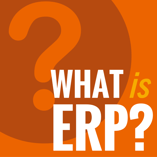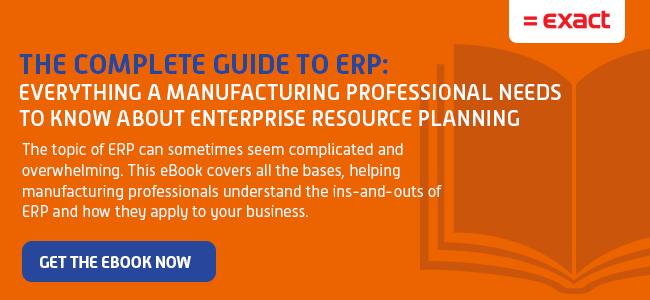An overview, brief history, and list of common Enterprise Resource Planning (ERP) terms and definitions
 As one of the longest standing ERP vendors, the fundamentals of ERP seem second nature to us here at MAX, and it isn’t until we’re posed with the question, “what actually is ERP?” that we’re reminded of how complex and intimidating the topic can seem to someone who’s new to the world of ERP. A quick Google search doesn’t quite answer this question either, which is what prompted us to write this blog series in the first place.
As one of the longest standing ERP vendors, the fundamentals of ERP seem second nature to us here at MAX, and it isn’t until we’re posed with the question, “what actually is ERP?” that we’re reminded of how complex and intimidating the topic can seem to someone who’s new to the world of ERP. A quick Google search doesn’t quite answer this question either, which is what prompted us to write this blog series in the first place.
What is ERP?
ERP is an industry acronym for Enterprise Resource Planning, but even the full name doesn’t give a great explanation of what ERP does. Broadly, ERP refers to a system that automates and integrates a company’s core business elements to increase efficiency and simplify operations. It is a comprehensive system that includes all the software pieces you might need to run your manufacturing operation.
For a deeper understanding of what ERP does, it’s helpful to take a step back and think about all of the processes that are essential to running a manufacturing business, including production planning, materials management, financials, customer relationship management (CRM), quality and compliance programs, customer service, and beyond. The purpose of ERP software is to have one complete system that supports and integrates all of these functions, in order to streamline processes and information across an entire organization. By creating a smooth flow of information that is always in sync, employees across all divisions (for example, accounting and sales) have access to the same, consistent information.
Most commercial ERP systems also offer synchronized reporting and automation tools. Instead of relying on separate databases and spreadsheets that employees need to consistently update, and then putting someone in charge of manually merging them all to generate reports, some ERP solutions give you the ability to pull reports from one central system. For example, with sales orders automatically flowing into the financial system without the need for the additional step of manually entering and sending new orders to the order management department, the order management department can process new orders more quickly and accurately, and the finance department can close the books faster.
Other common ERP features include a portal or dashboard to enable external stakeholders to securely access relevant information regarding the business's performance on key metrics. Most ERP systems can be deployed on-premises or in the cloud.
Where did ERP originate?
While the term ERP was coined in 1990, its roots date back to the sixties, when a researcher at IBM published research on the concept he dubbed material requirements planning, or “MRP.” His concept provided manufacturers with a method for planning the quantities of materials and components necessary to complete a production plan and the timing needed for phasing them so that the materials arrived very close to the time when they would be required to keep production running.
During next decade, material requirements planning morphed into manufacturing resource planning or “MRP II.” MRP II provided techniques for smoothing the production plan by adding capacity planning, scheduling, and forecasting to material requirements planning.
In the 1990’s, ERP Systems began to include operational processes, graphical user interfaces and back-office functions like human resources and accounting. ERP has continued to expand to encompass business intelligence and incorporate “front-office” functions. Efficiency of all work centers is the main goal of ERP.
With these advancements, companies of varying sizes and from a broad range of industries are now rapidly adopting ERP systems. This diversity can also be attributed to new ways of minimizing IT and infrastructure cost such as the availability of private cloud ERP solutions, which has made ERP more affordable, easier to implement, and more widely available. Although ERP is now used across industries, the heart of ERP software for manufacturers is still MRP.
Common ERP terminology:
- Enterprise Resource Planning (often called ERP, ERP system, or ERP software): A system that automates and integrates a company’s core business elements to increase effectiveness and simplify operations. It is a comprehensive system that includes all the software pieces you might need to run your manufacturing operation.
- Lean Manufacturing: A systematic method for the elimination of waste within a manufacturing system. Lean also takes into account waste created through overburden and waste created through unevenness in workloads.
- Business Activity Monitoring (often called BAM): A collection of tools that allow you to manage aggregations, alerts, and profiles to monitor relevant business metrics.
- Materials Requirement Planning (often called MRP): System that is primarily material oriented. Many ERP systems have grown from an MRP system. Finding an ERP system with strong MRP functionality is essential for manufacturers.
- Manufacturing Resource Planning (often called MRP): Acronym changed from Materials Requirements Planning to Materials Resource Planning during the decade of the seventies, which was known as the era of MRP II, and added scheduling, capacity planning, and simulation capabilities.
- Front-Office: A front office application is any software that has a direct relation to customers. It provides functionality and data necessary to take orders, configure complex products and provide effective service and support to customers. It includes customer relationship management (CRM), customer support, service management, document management, workflow process management, field service, etc.
- BOM: A bill of materials or product structure (sometimes bill of material, BOM or associated list) is a list of the raw materials, sub-assemblies, intermediate assemblies, sub-components, parts and the quantities of each needed to manufacture an end product. A BOM may be used for communication between manufacturing partners, or confined to a single manufacturing plant. A bill of materials is often tied to a production order whose issuance may generate reservations for components in the bill of materials that are in stock and requisitions for components that are not in stock.
- WYSIWYG: Acronym for “What you see is what you get;” Refers to a feature of a software tool that allows you to edit or input information and see it exactly as the data will appear and be displayed within the system, as compared to using codes or spreadsheet-style data entry that will be translated by the software and appear differently than it did during the data entry process.
- BPM: Business Process Management
- Cloud Deployment: A Private Cloud deployment lowers IT infrastructure overhead and ensures your data is protected around-the-clock within a managed data center. Private Cloud allows companies with remote sites to share the same ERP installation and data, enabling multi-site ERP software access
- On-Premise Deployment: A traditional ERP deployment that means installing the system onto servers in your facility. Companies that have an established IT infrastructure or are willing to invest in creating and maintaining their own servers are usually interested in implementing ERP on-premises.
- MCS: MCS stands for Manufacturing Control System. MCS is the generic model taught by APICS, the Society for Operations Management, on which ERP is built on. It visually expresses the design of any ERP system.
In conclusion, ERP software helps to eliminate redundant processes and systems, dramatically lowering the cost of doing business overall. ERP implementation is where planning and profitability intersect, allowing you to streamline your manufacturing processes with software that helps you achieve a more controlled, paperless shop floor. With ERP, you can rid yourself of duplicate data entries in disparate databases, unpredictable cost, quality and accuracy, and employee redtime, all of which cost you time and money, and hinder your manufacturing company’s potential for growth.
Download a copy of our eBook, “A Manufacturing Professional’s Complete Guide to ERP" to learn more!






